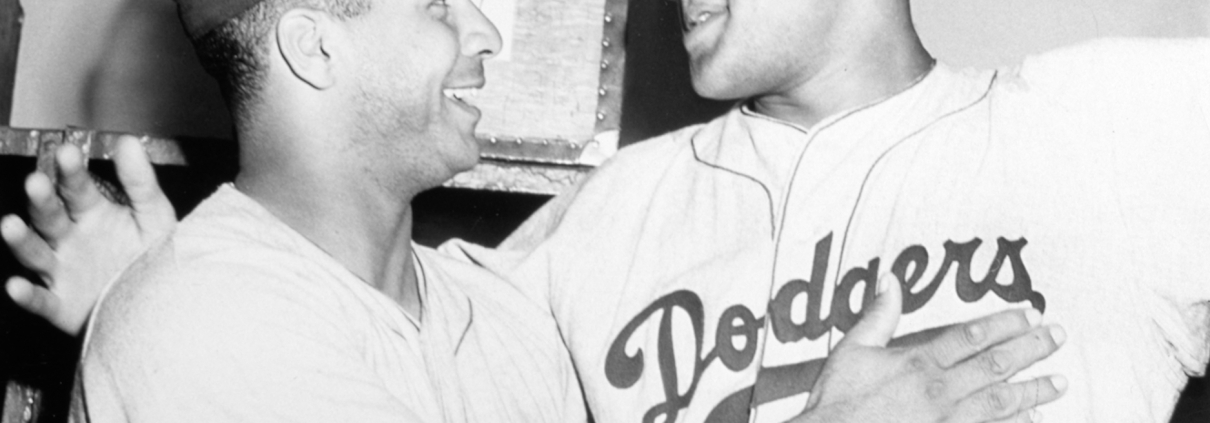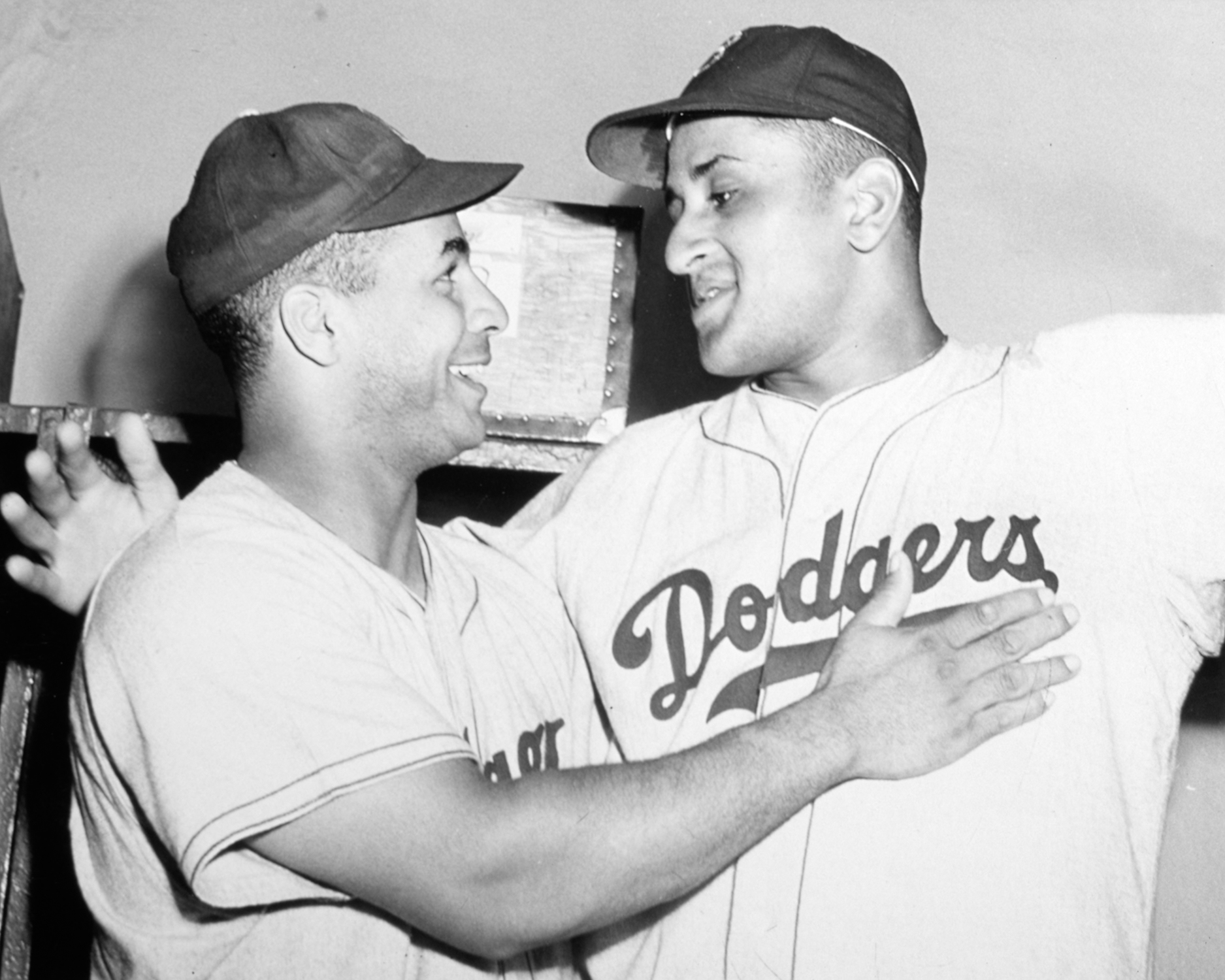July 17, 1954: Dodgers field first majority-Black lineup in National League history
Pitcher Don Newcombe (right) and catcher Roy Campanella were the battery for 183 starts as teammates with the Brooklyn Dodgers. (SABR-Rucker Archive)
Immediately after the All-Star Game in July 1954, the Brooklyn Dodgers traveled to Milwaukee’s County Stadium for a five-game series against the Braves. The defending National League champion Dodgers were struggling to keep pace with the first-place New York Giants, who had been boosted by Willie Mays’ return from Army service. The Braves were holding onto a spot in the first division of the NL.
A June rainout forced a makeup on July 14, the day after the All-Star Game at Cleveland Stadium.1 Brooklyn took the first game of the set, 2-1, in 12 innings, but the Braves bounced back to win both ends of a doubleheader on July 15, rallying from a five-run deficit with two outs in the ninth inning to take the nightcap. Milwaukee made it three wins in a row with a 6-1 victory on July 16.
Starting play on Saturday, July 17, the Dodgers were in second place, 6½ games behind the Giants, who had beaten them in six straight games in late June and early July. The fourth-place Braves were 14 games out of first and only a half-game behind the third-place Cincinnati Reds.
What happened next was both historic and possibly an act of necessity. First-year Brooklyn manager Walter Alston likely had not planned to start rookie left fielder Sandy Amorós that day. But when Alston made out the starting lineup, he inserted Amorós in the sixth spot even though the 24-year-old Cuban had gone only 3-for-17 in the first four games in Milwaukee.
The move was intriguing because the starting pitcher for the Dodgers on July 17 was Don Newcombe, taking the mound for the first time since the All-Star break. In addition to Amorós and Newcombe, the Brooklyn starting nine included second baseman Jim Gilliam, third baseman Jackie Robinson, and catcher Roy Campanella. Seven years after Robinson had broken baseball’s color barrier in 1947, it was the first-ever majority Black starting lineup in National or American League history.2
If the intent was to improve the offense, it did not pay off immediately as Amorós went 0-for-5, but the Dodgers prevailed, 2-1, in 11 innings. First baseman Gil Hodges singled home shortstop Pee Wee Reese in the top of the 11th, enabling Brooklyn to salvage its second win of the five-game series.
In July 1954 there were still five teams that had not integrated their rosters,3 and two other clubs had added their first Black players earlier in the 1954 season.
The Dodgers were the exception with five Black players, plus pitcher Joe Black, who had been sent to Triple-A Montreal in May.4 In fact, Brooklyn was the only major-league club with enough Black players on the roster to start a majority-Black lineup in 1954.
Jules Tygiel, in Baseball’s Great Experiment, summarized the “controversy” facing teams as more Black players entered the major leagues. Any racial issues in Brooklyn were magnified “because the Dodgers represented both baseball’s most intensely integrated team and the most closely watched.”5 In the spring of 1953, Tygiel noted, the “racial cauldron almost boiled over” when the Dodgers started Gilliam at second base and moved Robinson to third, where he replaced Billy Cox.
Amorós was a Triple-A star in Montreal who had been managed by Alston in the minors in 1953. Amorós was batting .361 in 66 games in Montreal to start the 1954 season; he also had 50 RBIs, 13 home runs, and 5 stolen bases.6 He clearly deserved a call-up, which he got in time to join the team for the July 14 game in Milwaukee. Alston quickly inserted Amorós in the Dodgers starting lineup where he joined three other nonpitcher Black players. By July 17, Newcombe was due to start and history was made.
Braves starter Dave Jolly and Newcombe engaged in a classic pitchers’ duel before the late heroics. In the bottom of the first, Newcombe surrendered a run on a walk to center fielder Bill Bruton, a single by second baseman Danny O’Connell, and a run-scoring hit by first baseman Joe Adcock.
The Dodgers tied the score in the second on a walk to Robinson, a groundout by Amorós to advance the runner, and a single by right fielder Carl Furillo to score Robinson.
Both pitchers settled in with no more scoring until the decisive 11th inning. Jolly was masterful for the Braves, giving up only four hits over 10 innings – all singles except a 10th-inning double by Furillo. Jolly struck out three while issuing six walks, one intentional. He was helped out by error-free defense from the Braves and double plays in the first, third, and ninth innings.
Newcombe was nearly as dominant as Jolly, scattering 10 hits over nine innings of work. He walked only two while collecting four strikeouts.7
The Braves nearly grabbed the win in the bottom of the 10th off Jim Hughes, who had relieved Newcombe. After two quick outs, shortstop Johnny Logan drew a walk and went to third as catcher Del Crandall singled to center. Crandall moved to second on defensive indifference, but pinch-hitter George “Catfish” Metkovich struck out to end the threat.
Lew Burdette, in relief of Jolly, came in to face the Dodgers in the 11th. Against the top of the order, Burdette walked Gilliam, who was retired when Reese bunted into a force at second. Center fielder Duke Snider singled to center, sending Reese to third base. Hodges was next and sent a high hopper over Eddie Mathews at third base, scoring Reese with what proved to be the winning run.
The Braves made it interesting in their half of the 11th. After two quick outs and a Mathews single, left fielder Henry Aaron – who began the day with a .277 batting average and 11 home runs as a 20-year-old rookie – sent a liner to center field that Snider made a great catch of to preserve the win.8
Hughes earned his fifth victory of the season with two innings of relief, and Burdette was saddled with his 11th loss while pitching just one inning. Notably, the Braves stranded 15 runners.
A tense, exciting game did not overshadow the historical significance of the day. “Five Negro players were in the starting lineup for the Dodgers, the most in one game in major league history,” said a United Press account in the Wisconsin State Journal.9
Decades later, Hank Aaron wrote of the game in his autobiography: “It was the first time a major league lineup had more black players than white – and if you think that wasn’t a big deal, you don’t know anything about the 1950s.”10
The Dodgers deployed Newcombe, Campanella, Gilliam, Robinson, and Amorós together in the lineup three more times in 1954. They scored a total of 29 runs in the three games, winning twice.11 Brooklyn’s 92-62 record left them in second place in the NL, five games behind the eventual World Series champion Giants.12
Amorós hit .255 in seven seasons with the Dodgers. His running catch of Yogi Berra’s fly ball, turned into a double play, in Game Seven of the 1955 World Series was instrumental in the Dodgers’ only World Series championship in Brooklyn.
Acknowledgments
This article was fact-checked by Tom Brown and copy-edited by Len Levin.
Sources
In addition to the sources cited in the Notes, the author consulted Baseball-Reference.com and Retrosheet.org.
https://www.baseball-reference.com/boxes/MLN/MLN195407170.shtml
https://www.retrosheet.org/boxesetc/1954/B07170MLN1954.htm
Notes
1 “Several Dodgers Complain, but Will Play Game July 14,” The Sporting News, July 14, 1954: 35. July 14 had originally been scheduled as the final day of the three-day All-Star break.
2 “Dodgers End Drouth,” Omaha (Nebraska) Morning World-Herald, July 18, 1954: 30. The AP write-up was carried by numerous papers: “Brooklyn made major league history by fielding a team which included five Negroes in the starting lineup. The others, in addition to Robinson, Newcombe and Gilliam were catcher Roy Campanella and Sandy Amorós in leftfield.”
3 The Washington Senators, New York Yankees, Philadelphia Phillies, Detroit Tigers, and Boston Red Sox had not integrated their major-league rosters by July 1954.
4 “Deals of the Week,” The Sporting News, June 9, 1954: 40. In his book Baseball’s Great Experiment, Jules Tygiel stated that “on July 17, Alston named a lineup which included all the black Dodgers, except pitcher Joe Black.” Tygiel appears to be mistaken in suggesting that Black was available to be part of the historic lineup. Black had been sent to Triple-A Montreal at the end of May where he joined Amorós, who had some early season appearances for the Dodgers. Amorós had been sent to Montreal in mid-May and was having an outstanding season before being recalled by the Dodgers. Jules Tygiel, Baseball’s Great Experiment, (New York: Oxford University Press, 1983 and 1997), 307. See also “Deals of the Week,” The Sporting News, July 21, 1954: 38, and Tommy Holmes, “Amorós’ Return May Aid Flock,” Brooklyn Daily Eagle, July 12, 1954: 12.
5 Tygiel, 306.
6 Roscoe McGowen, “Dodger ‘Help Wanted’ Call Brings .361 Sandy on Run,” The Sporting News, July 21, 1954: 11.
7 Newcombe faced the Braves two weeks later on July 31 at Ebbets Field. In that game, Milwaukee knocked him out in the second inning, and Adcock’s four home runs led the Braves to a 15-7 win.
8 Rhiannon Walker, “The Day the Brooklyn Dodgers Fielded Major League Baseball’s First Majority-Black Lineup,” Andscape, July 18, 2018, https://andscape.com/features/the-day-the-brooklyn-dodgers-fielded-major-league-baseballs-first-majority-black-lineup/.
9 “Hodges High Hopper Tips Braves in 11th, 2-1,” Wisconsin State Journal (Madison, Wisconsin), July 18, 1954: 45.
10 Hank Aaron with Lonnie Wheeler, I Had a Hammer – The Hank Aaron Story (New York: HarperCollins Publishers, 1991), 93-94.
11 The games were August 24 in Cincinnati (a 12-4 win over the Reds), September 6 at home against the Pittsburgh Pirates (a 9-7 Pirates win), and September 15 at home against Cincinnati (a 10-4 win over the Reds).
12 Milwaukee came in third, eight games back of New York.
Additional Stats
Brooklyn Dodgers 2
Milwaukee Braves 1
11 innings
County Stadium
Milwaukee, WI
Box Score + PBP:
Corrections? Additions?
If you can help us improve this game story, contact us.



